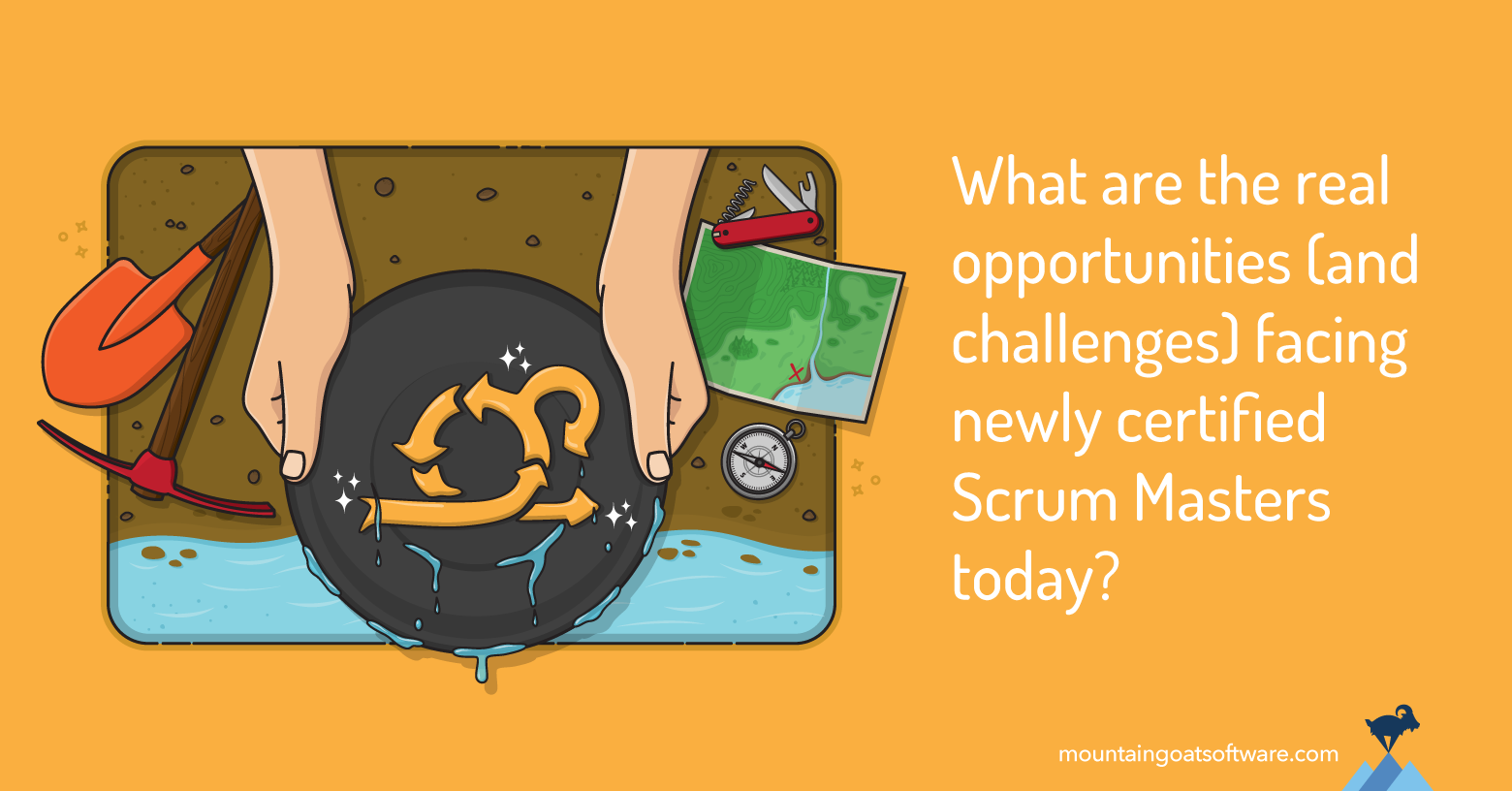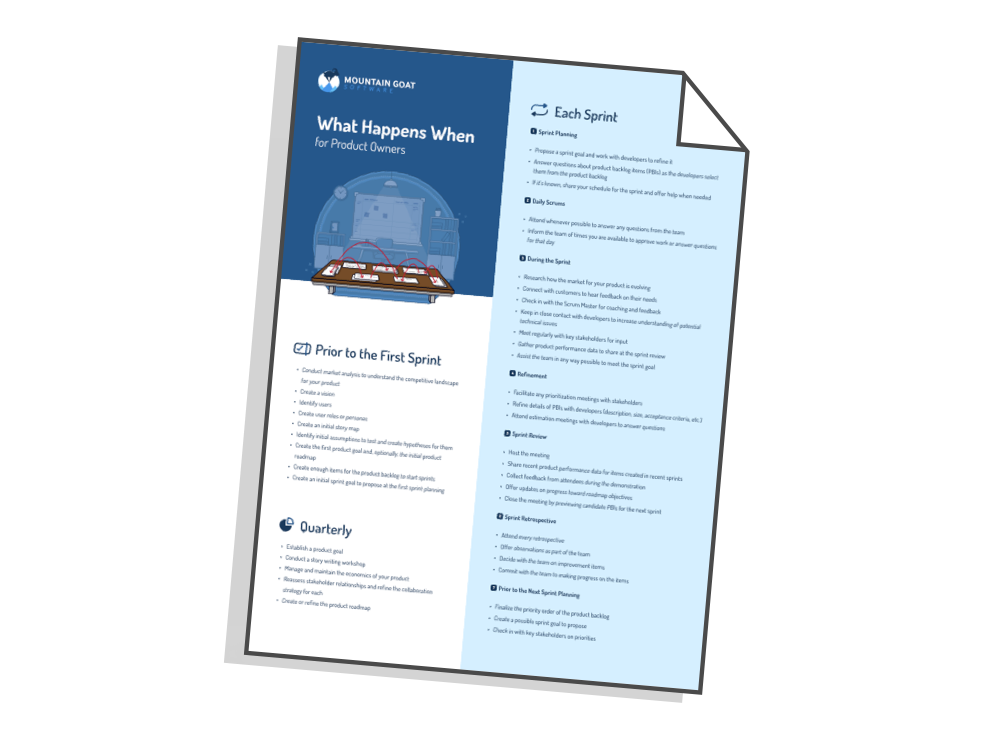Today’s post is from one of our Certified Scrum Trainers: Lance Dacy. I’ve known Lance for years and am always interested in his insights pertaining to Scrum and agile today. With Mountain Goat Software, he delivers both our CSM and CSPO courses. Interested in Training with Lance? Click here to see his upcoming certified Scrum course dates.
In 1848, James W. Marshall discovered gold in California.
The following year thousands braved treacherous journeys as they rushed to the West, inspired by a promise of making easy riches.
Of course it wasn’t that easy; you had to invest in a lot of equipment to get to the gold, the work was gruelling, and in a lawless society you were at constant risk of being attacked or robbed. For many, that dream never materialized and they returned empty-handed and disheartened.
In fact, it often wasn’t the miners who profited the most during this time, but the people who sold them their equipment.
So why am I asking whether 2020 is a gold rush year for Scrum Master jobs? Because I see a lot of similarities between today and that heady year of 1848.
There Is a Deluge of Job Opportunities (But Is that the Whole Picture?)
We’re definitely seeing a boom in Scrum Master jobs. LinkedIn ranked being a Scrum Master as one of the top 10 promising jobs of last year with a 67% year on year growth in job listings, and Glass Door puts the average annual salary in the US at $97,000.
This doesn’t surprise me.
Businesses are under more pressure to meet higher customer expectations with tight budgets and fewer resources. And it’s no longer only software companies that have to be agile: consumers expect fast delivery and better services in all aspects of their life. People want online banking facilities, they want to access secure and updated information from their healthcare providers. As a result we’re now seeing these traditionally slow-moving, risk-averse industries desperate to embrace agile.
This is creating opportunities for people who want to work on agile or Scrum teams because you no longer have to convince organizations why they should embrace these frameworks. Instead, these companies are actively saying:
Can you show us how to do it?
These companies know there is gold in them thar hills it’s likely they can operate more efficiently to increase profits if they transition to agile, but after years of waterfall they just don’t know where to start.
In short: they’re searching for gold but don’t know how to get it.
Just as the people selling gold-mining equipment profited by helping miners search for gold, so too can a great Scrum Master profit by helping these companies succeed.
So it would seem we have a landscape of opportunity: organizations desperate for guides, posting an increasing number of positions for Scrum Masters, with a rising rate in salary.
Add to this the fact that it’s more convenient now to get certified online as a Scrum Master, and it seems like the perfect time to take your certification and go panning for Scrum Master gold.
Or Is It?
I wish it was that simple—I really do—but there are a lot of newly qualified Scrum Masters who are finding the reality a lot more challenging.
If you’re newly certified looking for that first Scrum Master job you may be faced with...
Entry Level Pay… (Years of Experience Necessary)
A common and unpleasant wake-up call for people looking for their first Scrum Master position is that while most companies want you to be certified, a certification alone won’t get you hired. Most companies that are advertising lucrative salaries for a Scrum Master role also want you to have plenty of experience.
Remember all those risk-averse industries that are now moving to agile? They may have over 150 years of rote practices that are firmly entrenched and need to be unravelled before they have any hope of being successful.
They’re looking for guides to help, but those guides have a lot to do.
When you can walk into an organization, identify the top things they’re doing wrong, and show them how to fix them, you are more than worth a generous salary. But if you’re brand new to the Scrum Master role and the ink on your certification is still drying, it’s unlikely that you will have the experience to be confident in guiding them through this change (and making them believe you can do it).
It’s not just people applying for a new position that might face resistance. If you’re moving to a Scrum Master role in your current organization you might experience the following challenge.
Not Everyone Understands (Or Appreciates) the Value of a Scrum Master
If you’ve transitioned from a waterfall style of working to an agile framework like Scrum, you’ll know that some roles map more easily than others. Key stakeholders fill the role of product owner, while developers and business analysts fit easily into the roles of team members.
But the Scrum Master role is a bit more nuanced. It’s not quite a project manager role, although that’s a common misconception. My first year of being a Scrum Master, after being a project manager for years, was tough. I wanted to fix everything! I spent an entire year thinking that if the team had a problem, it was my job to fix it—and that wasn’t the case. I wasn’t helping the team solve their own problems or become self-organizing, which is essential for a Scrum Master.
In my experience, this can be challenging on two fronts.
If you’re new to the role of Scrum Master and from a project management background, you might struggle as I did with the notion of stepping back so that the team can help themselves.
But it can also be a challenge if the organization doesn’t fully understand the value of a Scrum Master. While some companies know the role exists, I still see decision-makers trying to combine it with another position because they’re sceptical that it should exist as a full-time job. The rationale is often: if you’re not actively fixing problems like a project manager would, then what are you doing? Just watching the team?
It’s Still a Great Time to Be a Scrum Master
I’m still positive about the opportunities new Scrum Masters face. I think more businesses will turn to agile to meet the competitive pressures they’re facing today.
And while I don’t think getting a great Scrum Master job is as easy as being certified and turning up, if you are just starting out, here’s the best advice I can give you to increase the chances of that job search paying off.
Make Sure You’re Personally Ready for the Role
I loved being a Scrum Master and personally believe it’s a truly rewarding job. But the rewards of this role are different than those of most occupations. We’re used to advancing in our careers or being promoted based on our personal contribution, and acknowledgment of that contribution. But as a Scrum Master, you have to be happy for the team to succeed without you taking praise for it.
If you can get excited because you’ve helped open doors for people in your team to experience new opportunities and advance their own careers, you’ll thrive as a Scrum Master and be invaluable to an organization.
We often say a Scrum Master needs to wear four hats: coach, facilitator, mentor, and teacher. Understanding this will help you adapt your style when the team needs you to. As a coach you might help a team discuss and explore options for removing impediments. You’ll be resisting the urge to fix the problem but instead supporting the team to make the decisions that will help them improve. You’ll experience a lot of facilitation as a Scrum Master, giving the team the space it needs in planning meetings or retrospectives so that members feel safe to raise and discuss ideas. Sharing your experience of what has worked well for other teams is a good way to mentor members, by way of story and illustration, without providing explicit instructions. And at times it will make sense for you to teach the team by sharing skills you might have that they can learn.
If you find the idea of helping others succeed exciting, it’s likely you have the aptitude to make a great Scrum Master.
You Don’t Need to BE a Scrum Master to Get Scrum Master Experience
Even if you’re prepared for the role personally, if you don't have experience it’s unlikely you can just walk into a well paid job.
So how can you get Scrum Master experience if you can’t get a Scrum Master job?
There are a few practical options to consider.
One might be to look for a small company to work for, perhaps even a start-up. If you can find a smaller company that is well-versed in agile, it can be easier to introduce and facilitate change across the organization. And while it may not provide the same salary as a larger corporation, that kind of company-wide influence is a great experience to point to in a future job interview.
Another option is what you might call a ‘side door’ entrance to the opportunity you want. Side door opportunities are an alternative to the direct route to your desired destination.
What’s great about a side door opportunity is that it’s usually a lot less crowded.
So instead of joining the 20 other people applying for that one Scrum Master role, keep your eyes out for any role that allows you to experiment with (or introduce) agile concepts.
This could be a position as a business analyst or developer. But honestly, the opportunities for you to introduce the Scrum principles to a team are not limited to software development. I’ve known some excellent Scrum Masters who gained valuable experience by applying agile concepts into a marketing department.
If you can’t walk into a Scrum Master role immediately after your certification, don’t despair. Even a year in a role where you have the opportunity to practice the techniques you’ve learned will mean you interview much better. You’ll have a broader range of experience and the ability to point to the results you’ve helped achieve.
Last update: June 24th, 2024




